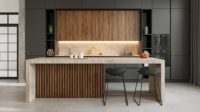I remember walking into a magnificent showroom in the early 1990s. Decorative plumbing showrooms had moved from rare to regular, but most were a simple, clean space with desks and manufacturer displays. This particular showroom’s space was originally built as an automobile showroom. Its windows soared to the roof and the terrazzo floor was stunning. This was a marvelous space. I smelled money.
Then I looked around and was surprised by the merchandising mix. The products were mostly mid-market, builder grade. I was confused until I met the owner and manager and they realigned my view of their business. They told me they had no desire to deal with the many unique deliverables for premium and luxury jobs. There are too many participants and these professionals and clients expect perfection. This showroom could not make that formula work, so they created and ran a mid-market builder showroom. The builder comes in, selects what they want and it's delivered when needed. Simple and profitable.
That day, I learned that the word "showroom" does not have to mean luxury; it does not always mean premium. A great showroom is a business that presents products that are carefully selected to fill the need of a significant, targeted customer niche. It does not mean that a showroom might occasionally reach outside its market focus to support a good client. It does mean that the product mix, pricing structure and quote pecking order are highly skewed toward both a specific market segment and targeted client definition. Adopting such a strong market and customer stance creates a strong product-market fit and companies with a strong market fit are market leaders and quite often highly profitable.
"The only thing that matters is getting to product/market fit,” entrepreneur and software engineer Marc Andreessen once said.
Defining product market fit is not an easy task for a stand-alone decorative plumbing showroom. It's especially complicated for showrooms that are a part of a multi-product brand that may supply PVF targeting plumbers, HVAC targeting builders or any of the many building products with re-distribution models.
Today, the phrase "decorative plumbing products" conjures up vastly different images in people’s minds. The term can refer to a shinny faucet in Home Depot or a hand-crafted, jewel-adorned gold lavatory ensemble from the French manufacturer THG. With such a broad definition, each showroom has the opportunity to discover the market they think best fits their talent and create its own unique decorative plumbing showroom’s brand definition. That definition then becomes the foundation to build your showrooms go-to-market strategy.
How can we do this without a deep dive into your brand's local market makeups and having to completely rework our showroom model?
Let’s keep it simple and build from your success. If your showrooms currently have a good history of generating a strong cash flow and profitability, we can build from that foundation. Ask your showroom sales data the following questions:
- What is your average single bathroom lavatory faucet?
- Sales dollar value?
- Percentage gross margin?
- What is your most profitable vendor by:
o Total dollars;
o Overall gross margin percentage; and
o Gross margin dollars per item.
“When a great team meets a lousy market, market wins. When a lousy team meets a great market, market wins. When a great team meets a great market, something special happens.”
-Andy Rachleff
Take those numbers and walk your showroom and see how they align with what you have on display. This information will show which displays are earning their rent and, more importantly, what market level your should be focusing on.
Let’s go back to the showroom data and ask it two more questions.
- What are your total sales and sales gross margin percentage selling to:
o Designers;
o Builders;
o Plumbers; and
o Homeowners?
- What are your total quotes and quote gross margin percentage for:
o Designers;
o Builders;
o Plumbers; and
o Homeowners?
I think these numbers will speak for themselves.
This is a simple process that will deliver information that will help you better understand your decorative showroom business. To add more depth to this information, reach out to your buying group network of like-business in non-competing markets and compare your information. Discuss your data versus theirs. There is nothing better than learning from trusted professionals by bouncing thoughts, processes and sharing information with your colleagues.
If you are still not comfortable adjusting your showroom based on these simple data points and your intra-trade group discussions, there are more in-depth methods hinted at about and we can discuss those in later articles. Please email me at jwvals@gmail.com with your thoughts and concerns.
Today competition is coming from all sides and the showrooms that will likely win their target market will be able to first identify their most advantageous target market and then laser focus on that market’s strongest customer.



